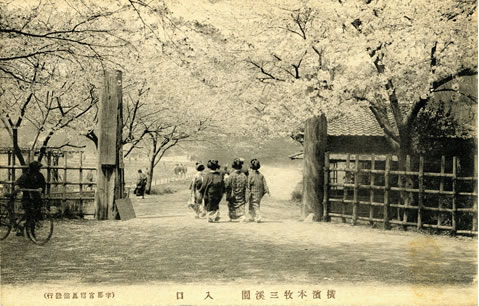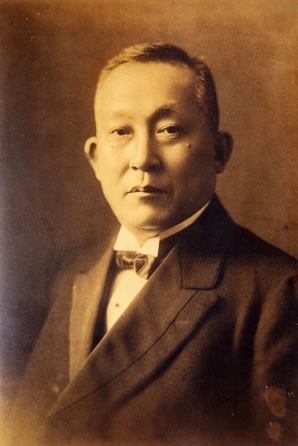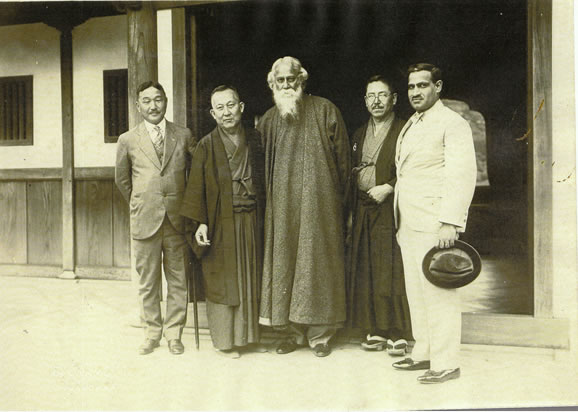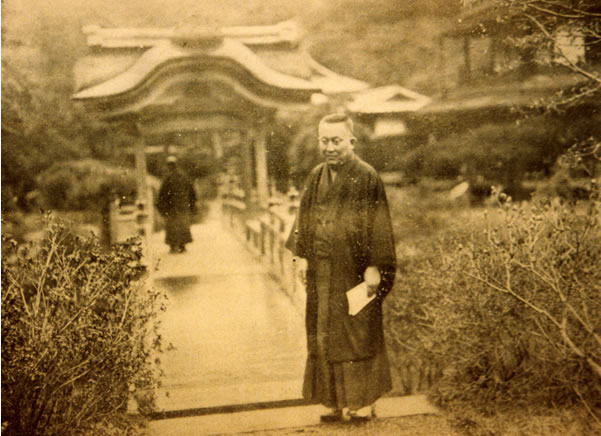歴史
三溪園の歴史
明治初年
原善三郎(三溪の養祖父)が三溪園一帯の土地を購入
明治20年代
原善三郎が三溪園の南端、本牧海岸寄りに山荘“松風閣”を建てる
1902年(明治35)
原三溪が原家の本宅“鶴翔閣”を建て、古建築の蒐集をはじめる
“旧天瑞寺寿塔覆堂”を入手
※この頃から、本名の富太郎ではなく、三之谷の地名から三溪と号する
1905年(明治38)
造園にあたり、庭師を関西方面に派遣
帰浜後、本格的な造園を開始
1906年(明治39)
5月1日 現在の外苑部分を無料で開園

1907年(明治40)
鎌倉山之内から“東慶寺仏殿”を移築
1908年(明治41)
“横笛庵”を建てる
梅林が完成し観梅会を開催
大正初年
下村観山が松風閣の障壁画「四季草花図」を描く
前田青邨が鶴翔閣に滞在し、「御輿振り」を描く
安田靫彦、前田青邨、小林古径等を招き、古美術鑑賞研究会を開く
1913年(大正2)
横山大観が“鶴翔閣”に滞在し「柳蔭」を描く
1914年(大正3)
京都相楽郡加茂の燈明寺から“三重塔”を移築
1915年(大正4)
下村観山が、三溪園の梅の木をモデルとして「弱法師」を描く
“臨春閣”の移築を開始(1917年工事完了)
1916年(大正5)
インドの詩聖タゴールが来園、松風閣に2か月半滞在し、詩「さまよえる鳥」を作る
鎌倉から“天授院”を移築する
1917年(大正6)
“蓮華院”を建てる
1918年(大正7)
“月華殿”、“春草廬”を移築
“金毛窟”を建てる
1920年(大正9)
“白雲邸”を建て、住まいとする
1922年(大正11)
“聴秋閣”を移築する
三溪による古建築移築の最後となる
1923年(大正12)
4月21・22日、内苑の完成を記念して大師会茶会を開く
(益田鈍翁・根津青山・服部莱々堂・仰木魯堂・森川如春等が席主をつとめる)
9月1日、関東大震災により“松風閣”他、一部の建物が倒壊・損壊する
1945年(昭和20)
空襲で大きな被害を受ける
1953年(昭和28)
原家から庭園の大部分を譲り受け、復旧工事に着手
財団法人三溪園保勝会設立
1954年(昭和29)
外苑の一般公開を始める
1958年(昭和33)
全体の復旧工事が終了し、内苑を初めて公開
1960年(昭和35)
岐阜県白川郷から“矢箆原家住宅”を移築
1963年(昭和38)
三溪園前面の本牧海岸の埋め立てが始まる
1970年(昭和45)
宗徧流林洞会から茶室“林洞庵”が寄贈される
隣接地が本牧市民公園となり、南門を設ける
1976年(昭和51)
臨春閣に、あらたに障壁画(中島清之・千波筆)を制作
1982年(昭和57)
聴秋閣奥の溪流沿い遊歩道を復元し、以後、季節公開する
“燈明寺本堂”の移築を開始する(1987年工事完了)
1989年(平成元)
三溪記念館を開館。三溪に関する資料や収集品等を展示する
2000年(平成12)
三溪の旧宅“鶴翔閣”を整備・復元
2007年(平成19)
国の名勝に指定される
原 三溪について

原 三溪(本名 富太郎)
1868年(慶応4)- 1939年(昭和14)
明治・大正・昭和の前半期にかけて、生糸貿易で財を成した実業家。
日清戦争、日露戦争、第一次世界大戦、関東大震災、世界恐慌、そして昭和の大恐慌と、歴史上まれにみる激動の時代において、みずからの事業はさておいて、蚕糸業界、横浜の経済界、そして社会のために尽くす姿勢を貫きました。
その対象は、文化の保護や振興、横浜の都市基盤の整備から、社会的な弱者を救済する社会福祉まで多岐に渡り、特に、関東大震災で壊滅的な打撃を受けた横浜の復興には、文字通り私財をなげうち、自らの身を挺してこれにあたり、「横浜の恩人」と呼ばれました。
また、三溪園についても、「この明媚な自然の風景は創造主のものであって、私有物ではない」と明言し、明治39年から広く一般に公開しました。
1868年(慶応4)
岐阜県厚見郡佐波村(現在の岐阜県岐阜市柳津町)で、代々に渡庄屋をつとめた青木家の長男として生まれる
1885年(明治18)
東京専門学校(現在の早稲田大学)に入学、政治・法律を学ぶ
1891年(明治24)
教え子であった原善三郎の孫娘、屋寿と結婚し、原家に入籍
1900年(明治33)
原商店を合名会社に改組し経営の近代化に努め、日本の5大生糸輸出業者の仲間入りを果たす
1902年(明治35)
自邸を野毛山から本牧三之谷・三溪園に移す
1906年(明治39)
三溪園を無料開園
1923年(大正12)
関東大震災後は、横浜市復興会長に就任
1925年(大正14)
直接国税総納額23,979円で、神奈川県のトップにランクされる
1939年(昭和14)
白雲邸にて享年70にて逝去
実業家として
三溪は、原家に婿養子として入り、先代・善三郎が興した生糸売込商・原商店を31歳で引き継ぎます。この時代、生糸は常に輸出品のトップの座にあり、日本の経済を支える文字通りの大黒柱でした。
三溪は、経営の近代化、国際化に力を注ぎ、個人商店であった原商店を原合名会社に改組し、近代的な事業経営を次々と展開しました。三溪の経営の視点は常に「私」ではなく「公」にあり、例え自社には不利益なことであっても、それが蚕糸業界、とりわけ横浜の利益になることであれば、進んで「私」を無にする姿勢を貫きました。
金融業界においても、横浜銀行の前身・横浜興信銀行の初代頭取、横浜市信用組合長などを歴任するなど、横浜の発展に尽くし、1923年(大正12)の関東大震災時には横浜市復興会長として横浜の復興に奮闘しました。
パトロンとして

製糸・生糸貿易で財を成した三溪は、古美術と近代日本美術の大コレクターでもありました。
明治の終わりごろからは、日本美術院を中心とした画家の支援を始め、物心両面から支えました。横浜出身で日本美術院の創設者・岡倉天心を通じて多くの画家を見出し、若手の育成を支援したのです。研究のための奨励金を出したり、作品を買い上げるほか、制作の場を提供したり、蒐集品の鑑賞会を行ったりと、支援のかたちは多岐にわたります。
三溪園内で三溪が住まいとした鶴翔閣は、横山大観や前田青邨といった画家たちが集い、滞在して絵を制作するなど、文化サロンとしての役割も果たした場所です。古美術を中心とした三溪の蒐集品は、鶴翔閣で若手作家へ供覧され、彼らの創作活動に重要なヒントを与えました。三溪が見込んだ画家はその支援により、各展覧会での受賞や後世に傑作といわれた名作を生むという成果を出しました。
文人として
三溪は、母方の祖父が南画家・高橋友吉(号 杏村)という環境もあり、幼くして南画、漢籍、詩文の教養を身につけ、絵については10歳の頃から叔父の高橋鎌吉(杏村の長男/号 抗水)に学びました。
江戸時代の文人が本職ではなく余技としてたしなんだ南画の伝統を引き継ぎ、三溪も事業を手掛けるかたわら伸び伸びとした筆致で和やかな絵を描き、自ら絵筆をとり漢詩を作る「文芸の人」でもありました。
茶人として

20代の頃より煎茶を趣味としていた三溪は、49歳頃から本格的に茶の湯の世界に親しむことになります。ほかの多くの実業家と同様に、自身の財力と鑑識眼によって茶道具を蒐集し、茶会を開き、各界の名士たちと交流を深めたのです。三井物産の創始者・益田鈍翁(本名 孝)、電力王と称された松永耳庵(本名 安左エ門)とともに、近代三茶人の一人に数えられます。
自ら構想した茶室「蓮華院」の完成を記念した茶会をはじめ、1923年(大正12)に三溪園全園の完成をもって開催された大師会茶会など、今でも語り継がれる茶会が三溪園で営まれました。


















